Ayurvedic Lifestyle: Balancing Mind, Body, and Spirit
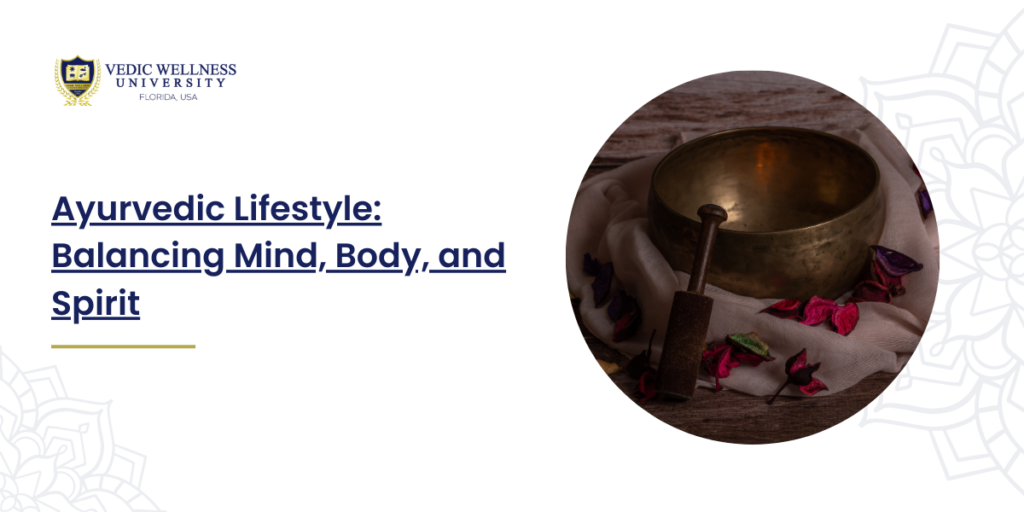
Introduction “धर्मार्थकाममोक्षाणामारोग्यं मूलमुत्तमम्।आरोद्योगमाहारसमुत्तिष्ठत्यायुषः परम्॥”(Dharmartha-Kama-Mokshanam Arogyam Moolamuttamam,Aarogyam Aaharam Saamyak Samutthishthati Ayushah Param)“Health is the greatest foundation for the attainment of Dharma (duty), Artha (wealth), Kama (desire), and Moksha (liberation). Proper nutrition promotes longevity and well-being.” This verse from the Sushruta Samhita underscores the essence of Ayurveda and its comprehensive impact on holistic well-being. Ayurvedic, an ancient system of medicine, emphasizes the balance of mind, body, and spirit to achieve optimal health and harmony. It provides a framework for understanding the natural constitution of an individual and the means to maintain balance through diet, lifestyle, and natural therapies. Basic Principles of Ayurveda Ayurveda is based on several fundamental principles that guide its holistic approach to health and well-being. Here are some of the core principles: 1. Doshas (Bio-Energies) Ayurveda identifies three primary doshas—Vata, Pitta, and Kapha. These doshas are biological energies found throughout the human body and mind, governing all physical and mental processes. 2. Prakriti (Constitution) Each individual has a unique combination of doshas, known as their Prakriti. This constitution determines physical characteristics, mental tendencies, and emotional behaviors. Understanding one’s Prakriti helps tailor personalized health and wellness plans. 3. Agni (Digestive Fire) Agni, or digestive fire, is central to health in Ayurveda. It is responsible for digestion, absorption, and assimilation of nutrients. Balanced Agni leads to good health, while impaired Agni results in illness. 4. Dhatus (Tissues) The body is made up of seven dhatus or tissues—Rasa (plasma), Rakta (blood), Mamsa (muscle), Meda (fat), Asthi (bone), Majja (marrow), and Shukra (reproductive tissue). The health of these dhatus is crucial for overall well-being. 5. Malas (Waste Products) Proper elimination of malas (waste products) is essential for health. These include urine, feces, and sweat. Regular cleansing of the body through detoxification practices is emphasized. The Ayurvedic Lifestyle An Ayurvedic lifestyle encompasses various practices aimed at maintaining balance and promoting holistic health. These include diet, daily routines, seasonal practices, and spiritual disciplines. 1. Diet (Ahara) “हितं सुखं दानं सान्निध्यं, प्रीणनं सन्तोषवर्धनम्।आयुष्यं बलकृत्प्रज्ञं सर्व रोग निवारणम्॥”(Hitam Sukham Daanam Saannidhyam, Preenanam Santoshavardhanam,Aayushyam Balakritprajnam Sarva Roga Nivaranam)“Wholesome food provides happiness, contentment, and good health. It promotes longevity, strength, and wisdom, and prevents all diseases.” Ayurveda emphasizes the importance of a balanced diet tailored to an individual’s constitution (Prakriti) and current state of health (Vikriti). Foods should be fresh, seasonal, and appropriate for one’s dosha. Meals should be consumed mindfully, and incompatible food combinations should be avoided. 2. Daily Routine (Dinacharya) “उषः कालं प्रबुद्ध्यायं चेष्टते हितमेव च।दोषाणां समता यान्ति व्याधयः पलायनम्॥”(Ushah Kalam Prabuddhyayam Cheshtate Hitameva Cha,Doshanam Samata Yanti Vyadhayah Palayanam)“Waking up early and following a healthy routine brings balance to the doshas and prevents diseases.” Dinacharya includes practices such as waking up early, oral hygiene, self-massage (Abhyanga), yoga, and meditation. It sets the tone for the day, ensuring physical and mental preparedness for daily activities. 3. Seasonal Practices (Ritucharya) “ऋतुषु स्वभावेण जायते च, स्थिराः सर्वे विनाशनम्।ऋतुसंधि समये युज्येत नित्यमुपचारेण योगवित्॥”(Ritushu Swabhavena Jayate Cha, Sthirah Sarve Vinashanam,Ritusandhi Samaye Yujyeta Nityam Upacharene Yogavit)“Adapting to seasonal changes by altering diet and lifestyle maintains health and prevents diseases.” Ritucharya involves adapting one’s diet and lifestyle to the changing seasons to maintain balance and prevent seasonal ailments. Each season has specific guidelines for diet, exercise, and detoxification practices. 4. Spiritual Practices (Adhyatma) “अयं निजः परो वेत्ति गणना लघुचेतसाम्।उदारचरितानां तु वसुधैव कुटुम्बकम्॥”(Ayam Nijah Paro Vetti Ganana Laghuchetasam,Udaracharitanam Tu Vasudhaiva Kutumbakam)“This is mine, that is yours, is the calculation of the narrow-minded. For the magnanimous, the whole world is a family.” Spiritual practices in Ayurveda include meditation, prayer, chanting, and self-reflection. These practices enhance mental clarity, emotional stability, and spiritual growth, contributing to overall well-being. Mind, Body, and Spirit in Ayurveda Ayurveda links the mind, body, and spirit, emphasizing their interconnectedness and the need for balance among them to achieve holistic health. 1. Mind (Manas) “योगः चित्तवृत्ति निरोधः”(Yogah Chitta Vritti Nirodhah)“Yoga is the cessation of the fluctuations of the mind.” Mental health is a crucial aspect of Ayurvedic wellness. Practices such as meditation, mindfulness, and positive thinking are recommended to maintain mental balance. Ayurveda also uses herbs like Brahmi and Ashwagandha to support mental health and cognitive function. 2. Body (Sharira) “सर्वे भवन्तु सुखिनः, सर्वे सन्तु निरामयाः।सर्वे भद्राणि पश्यन्तु मा कश्चिद्दुःखभाग्भवेत्॥”(Sarve Bhavantu Sukhinah, Sarve Santu Niramayah,Sarve Bhadrani Pashyantu Ma Kashchidduhkhabhagbhavet)“May all beings be happy, may all be free from disease, may all experience auspiciousness, and may no one suffer.” Physical health in Ayurveda is maintained through balanced nutrition, regular exercise, proper sleep, and detoxification practices. Yoga and Ayurvedic massages (Abhyanga) are integral to maintaining physical health and flexibility. 3. Spirit (Atman) “आत्मनं रथिनं विद्धि शरीरं रथमेव तु।बुद्धिं तु सारथिं विद्धि मनः प्रग्रहमेव च॥”(Atmanam Rathinam Viddhi Shariram Rathameva Tu,Buddhim Tu Sarathim Viddhi Manah Pragrahameva Cha)“Know the self as the rider, the body as the chariot, the intellect as the charioteer, and the mind as the reins.” Spiritual health involves connecting with one’s higher self and understanding the purpose of life. Practices like meditation, self-reflection, and devotion (Bhakti) help in nurturing the spirit and achieving inner peace. Vedic Wellness University’s Dedication to Ayurveda Vedic Wellness University is dedicated to promoting Ayurveda and traditional Indian practices through comprehensive courses and programs. Our curriculum integrates ancient wisdom with modern practices to offer a holistic education in Ayurveda. Courses Offered: How to Enroll: Prospective students can visit the Vedic Wellness University website to learn more about the courses and enrollment process. Scholarships and financial aid options are available for eligible students. Conclusion “वसुधैव कुटुम्बकम्”(Vasudhaiva Kutumbakam)“The world is one family.” Embracing an Ayurvedic lifestyle can lead to a balanced and harmonious life, promoting the well-being of the mind, body, and spirit. Vedic Wellness University is committed to spreading the wisdom of Ayurveda and other traditional Indian practices to foster a global community of health and wellness. By integrating ancient principles with modern education, we aim to empower individuals to lead healthier and more fulfilling lives.
From Beginner to Expert: The Best Courses in Astrology for Every Level
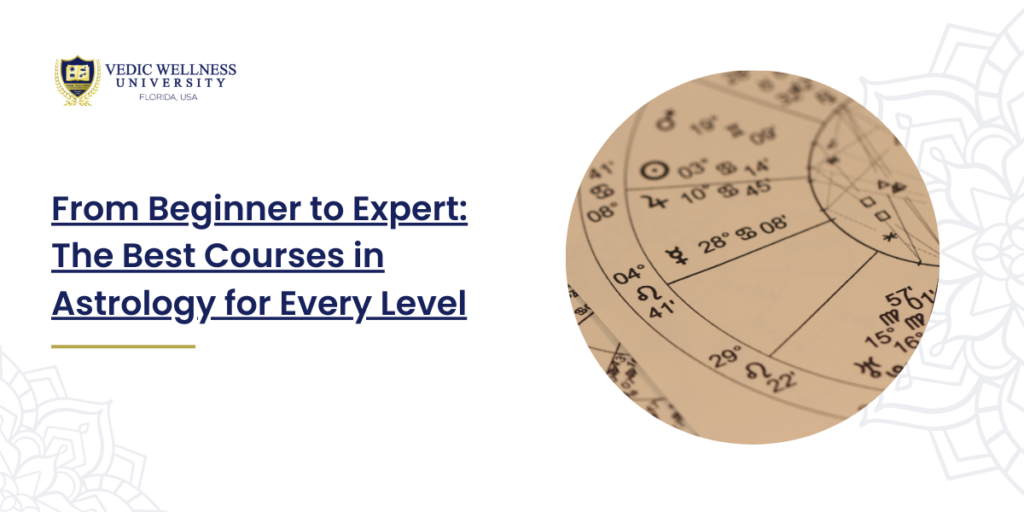
Introduction Did you know that astrology has been practiced for over 4,000 years and has influenced many aspects of human culture and behavior? Despite the occasional skepticism, astrology plays a significant role in our lives, often influencing decisions and perceptions. Courses in astrology From determining auspicious dates for weddings to guiding significant life choices, astrology is intertwined with our cultural and personal narratives. While some may view it with humor, the impact of astrology on our lives cannot be ignored. Astrology merges ancient wisdom with mathematical precision, involving complex calculations and interpretations that predict potential outcomes and probabilities. Far from being a mere collection of horoscopes, astrology is a detailed study requiring rigorous training and understanding. Let’s explore how you can transition from a beginner to an expert through various structured courses in astrology. The Complex Nature of Astrology Astrology is not something that can be mastered through random online searches. It is a sophisticated discipline involving intricate calculations and deep knowledge of celestial bodies. A single error in calculation can lead to incorrect predictions, making precision crucial. Unfortunately, many people reduce astrology to simplistic horoscopes, missing its profound complexity. True astrology involves understanding planetary movements, astrological charts, and their probabilities. “सर्वं ज्ञानं मयि विद्यते”(Sarvaṁ Jñānaṁ Mayi Vidyate)“All knowledge is within me.” This shloka from the Rigveda reminds us of the depth of knowledge inherent in each individual, and astrology is one avenue through which this knowledge can be explored and understood. Deciding Factors Before Learning Astrology Before embarking on a journey to learn astrology, here are seven critical factors to consider: 1. Mathematical Aptitude Astrology involves complex calculations. A strong foundation in mathematics is crucial for accurate chart readings and predictions. Understanding planetary positions, angles, and movements requires precision. 2. Interest in Astronomy A genuine interest in astronomy can enhance your understanding of astrology. Knowing about celestial bodies and their movements forms the backbone of astrological studies. 3. Cultural Understanding Astrology is deeply rooted in cultural contexts. Understanding different cultural perspectives on astrology can provide a holistic view of this ancient practice. 4. Intuitive Thinking Astrology is not just about calculations; it also requires intuitive thinking to interpret charts and predictions. An intuitive mind can connect the dots between celestial movements and human behavior. 5. Commitment to Continuous Learning Astrology is an ever-evolving field. Staying updated with new findings and interpretations requires a commitment to continuous learning and exploration. 6. Ethical Considerations Astrology has a profound impact on people’s lives. Ethical practice, including honesty and integrity, is essential for building trust and credibility as an astrologer. 7. Communication Skills Effective communication is vital for conveying complex astrological concepts to clients. Clear and empathetic communication can enhance client relationships and trust. Courses in Astrology for Every Level Astrology courses are designed to cater to different levels of learners, from beginners to advanced practitioners. Here are some key courses offered at Vedic Wellness University and what you can expect from each: 1. Introduction to Astrology (Beginner Level) This course covers the basics of astrology, including the history of astrology, understanding the zodiac signs, planets, houses, and aspects. It is ideal for those new to astrology who want to understand its fundamental principles. 2. Intermediate Astrology (Intermediate Level) Building on the basics, this course delves into more detailed chart interpretations, transits, and progressions. Students will learn to create and interpret more complex astrological charts. 3. Advanced Astrology (Advanced Level) This course is for those who want to specialize in specific branches of astrology, such as medical astrology, financial astrology, or electional astrology. It includes advanced predictive techniques and in-depth chart analysis. 4. Professional Diploma in Astrology A comprehensive program that combines theoretical knowledge with practical applications. This course prepares students for a professional career in astrology, including setting up their practice. 5. Post-Graduate Diploma in Astrology This program is designed for those who wish to pursue advanced research in astrology. It involves in-depth study and research in various astrological theories and practices. 6. PhD in Astrology The highest level of academic qualification in astrology, this program involves extensive research and contributes new knowledge to the field of astrology. Conclusion “आ नो भद्राः क्रतवो यन्तु विश्वतः”(ā no bhadrāḥ kratavo yantu viśvataḥ)“Let noble thoughts come to us from every side.” Astrology is a profound field that bridges the gap between ancient wisdom and modern scientific inquiry. With the right training and commitment, you can transition from a beginner to an expert in astrology, opening up a world of opportunities and insights. Vedic Wellness University offers comprehensive courses in astrology for every level, ensuring that you gain the knowledge and skills needed to excel in this fascinating discipline. Whether you are starting your journey or looking to deepen your expertise, these courses provide a structured path to mastering the art and science of astrology.
What Is Vedic Mathematics? Discover Its Key Benefits
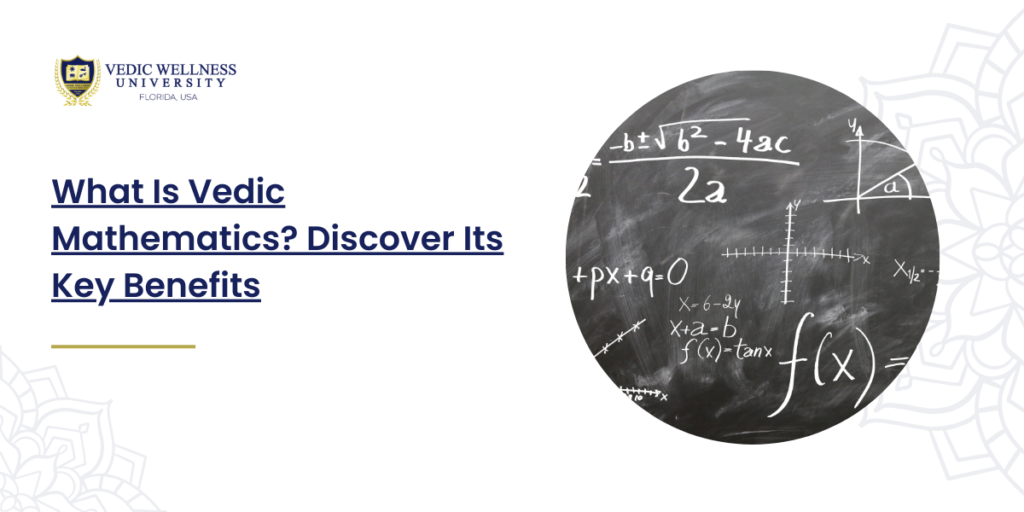
Introduction “सर्वं ज्ञानं मयि विद्यते”(Sarvaṁ Jñānaṁ Mayi Vidyate)“All knowledge is within me.” This ancient shloka from the Rigveda encapsulates the essence of Vedic Mathematics, a system that reveals the inherent knowledge within each individual. Vedic Mathematics, derived from ancient Indian scriptures, is a unique and powerful system of mathematics that simplifies complex calculations through mental arithmetic and intuitive methods. Origins and Timeline of Vedic Mathematics Vedic Mathematics originates from the Vedas, the oldest sacred texts of Hinduism, particularly the Atharva Veda. The system was rediscovered and compiled in the early 20th century by Swami Bharati Krishna Tirthaji, who extracted sixteen sutras (aphorisms) and thirteen sub-sutras from the Vedas, forming the foundation of Vedic Maths. Timeline of Advancements: Prominent Advocates of Vedic Mathematics 1. Swami Bharati Krishna Tirthaji Swami Bharati Krishna Tirthaji is the modern founder of Vedic Mathematics. His work in extracting and compiling the sixteen sutras revolutionized the way mathematics is taught and practiced. 2. Aryabhata An ancient Indian mathematician and astronomer, Aryabhata’s works laid the groundwork for future advancements in mathematics, including concepts that align with Vedic Maths. 3. Bhaskara II Author of “Lilavati” and “Bijaganita,” Bhaskara II’s contributions to algebra and arithmetic are foundational to many principles in Vedic Mathematics. 4. Brahmagupta His text “Brahmasphutasiddhanta” introduced zero and negative numbers, concepts integral to mathematical calculations and Vedic Maths. 5. Ramanujan Although not directly linked to Vedic Maths, the mathematical genius of Srinivasa Ramanujan reflects the intuitive and mental arithmetic prowess that Vedic Mathematics promotes. 6. P.C. Mahalanobis A contemporary statistician who valued traditional Indian methods, Mahalanobis supported the integration of ancient mathematical wisdom with modern practices. 7. Shakuntala Devi Known as the “Human Computer,” Shakuntala Devi’s mental arithmetic abilities are a testament to the power of intuitive calculation methods similar to those in Vedic Maths. 8. Dr. Manjul Bhargava A modern mathematician whose work in number theory resonates with the principles of Vedic Mathematics, promoting mental calculations and simplicity. 9. D.R. Kaprekar Famous for discovering Kaprekar’s constant, his work in recreational mathematics aligns with the playful and exploratory nature of Vedic Maths. 10. T.V. Seshadri An advocate of Vedic Mathematics, T.V. Seshadri worked extensively to promote and teach the system, emphasizing its practical applications in modern education. Scope of Vedic Mathematics Vedic Mathematics offers vast potential in various fields, providing numerous career opportunities. Professionals proficient in Vedic Maths can pursue careers as educators, researchers, data analysts, financial analysts, and software developers. Here are some potential career paths and their expected remunerations: Courses in Vedic Mathematics Vedic Wellness University offers a range of courses focused on Vedic Mathematics, designed to cater to different levels of expertise and interest. These courses include: These courses combine traditional Vedic wisdom with modern educational practices, providing students with a holistic understanding of mathematics and its applications. Conclusion “आ नो भद्राः क्रतवो यन्तु विश्वतः”(ā no bhadrāḥ kratavo yantu viśvataḥ)“Let noble thoughts come to us from every side.” Vedic Mathematics is not just an ancient system but a revolutionary approach to simplifying mathematical calculations and fostering mental agility. Its principles are timeless, offering significant benefits in education, professional fields, and everyday life. Vedic Wellness University is dedicated to preserving and promoting this ancient knowledge, integrating it with contemporary relevance to empower individuals worldwide. Embrace the wisdom of Vedic Maths and discover the profound impact it can have on your intellectual and professional growth.
Top 10 Herbal Remedies in Ayurveda for Everyday Health
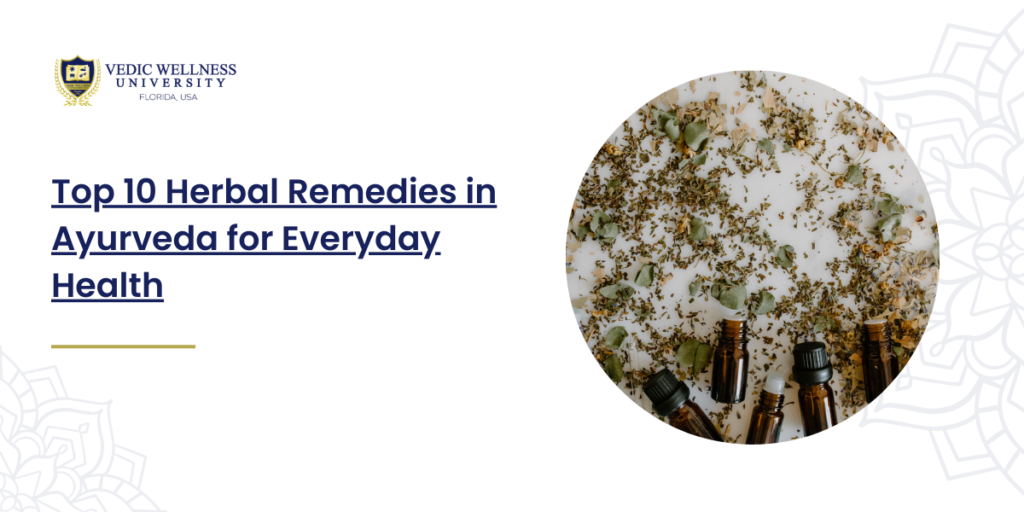
Introduction “सर्वे भवन्तु सुखिनः, सर्वे सन्तु निरामयाः।”(Sarve Bhavantu Sukhinah, Sarve Santu Niramayah)“May all be happy, may all be free from disease.” This ancient shloka encapsulates the essence of Ayurveda, the traditional Indian system of medicine that aims to promote health and well-being for all. Ayurveda, which means “the science of life,” is a holistic approach to health that emphasizes balance in the body, mind, and spirit. Central to Ayurvedic practice are herbal remedies, which have been used for thousands of years to treat a wide range of ailments and promote overall health. Importance of Herbal Remedies in Ayurveda Herbal remedies are a cornerstone of the Ayurvedic healthcare system. They are derived from various parts of plants, including leaves, roots, bark, seeds, and flowers, and are used to balance the body’s doshas (Vata, Pitta, and Kapha) and support the body’s natural healing processes. In Ayurveda, each herb has specific properties that can help in treating diseases, boosting immunity, and maintaining overall health. Herbal remedies are particularly valued for their natural origins and minimal side effects compared to synthetic medications. They are used to treat a wide variety of health conditions, from common colds and digestive issues to chronic diseases and mental health disorders. In addition to treating illnesses, Ayurvedic herbs are also used to enhance physical strength, mental clarity, and emotional stability. Vital Herbs Used in Ayurveda 1. Ashwagandha (Withania somnifera) Properties and Benefits: Ashwagandha, also known as Indian ginseng, is a powerful adaptogen that helps the body cope with stress. It enhances stamina, boosts immunity, and improves overall vitality. Uses: How to Use: Ashwagandha can be consumed as a powder mixed with milk or water, or taken in capsule form. It is commonly found in health food stores and Ayurvedic shops worldwide. 2. Turmeric (Curcuma longa) Properties and Benefits: Turmeric is renowned for its anti-inflammatory and antioxidant properties. The active compound, curcumin, is effective in reducing inflammation and supporting joint health. Uses: How to Use: Turmeric can be added to food as a spice or taken as a supplement in powder or capsule form. It is widely available in grocery stores and herbal shops. 3. Tulsi (Ocimum sanctum) Properties and Benefits: Tulsi, or holy basil, is revered in Ayurveda for its medicinal properties. It is a powerful adaptogen that supports respiratory health and reduces stress. Uses: How to Use: Tulsi leaves can be brewed as tea, used in cooking, or taken as a supplement. It is commonly available in health food stores and Ayurvedic shops. 4. Ginger (Zingiber officinale) Properties and Benefits: Ginger is widely used in Ayurveda for its digestive and anti-inflammatory properties. It aids digestion, reduces nausea, and supports cardiovascular health. Uses: How to Use: Ginger can be consumed fresh, as a tea, or in powdered form. It is readily available in grocery stores and herbal shops. 5. Neem (Azadirachta indica) Properties and Benefits: Neem is known for its antibacterial, antifungal, and antiviral properties. It supports skin health and detoxifies the body. Uses: How to Use: Neem can be used in various forms, including capsules, powders, oils, and soaps. It is available in Ayurvedic and health food stores. 6. Amla (Emblica officinalis) Properties and Benefits: Amla, or Indian gooseberry, is rich in vitamin C and antioxidants. It supports immune function and enhances skin and hair health. Uses: How to Use: Amla can be consumed fresh, as juice, or in powdered form. It is widely available in health food stores and Ayurvedic shops. 7. Brahmi (Bacopa monnieri) Properties and Benefits: Brahmi is a powerful herb for cognitive enhancement. It improves memory, reduces stress, and supports mental clarity. Uses: How to Use: Brahmi can be taken as a supplement in capsule or powder form, or brewed as tea. It is available in health food stores and Ayurvedic shops. 8. Triphala Properties and Benefits: Triphala is a combination of three fruits: Amla, Haritaki, and Bibhitaki. It supports digestive health and detoxification. Uses: How to Use: Triphala is commonly taken as a powder mixed with water or as a capsule. It is available in Ayurvedic and health food stores. 9. Shatavari (Asparagus racemosus) Properties and Benefits: Shatavari is known for its benefits in women’s health. It supports reproductive health, balances hormones, and enhances lactation. Uses: How to Use: Shatavari can be taken as a powder mixed with milk or water, or as a supplement in capsule form. It is available in health food stores and Ayurvedic shops. 10. Licorice (Glycyrrhiza glabra) Properties and Benefits: Licorice is known for its soothing properties. It supports respiratory health, soothes the digestive tract, and reduces inflammation. Uses: How to Use: Licorice can be consumed as tea, in powder form, or as a supplement. It is available in health food stores and Ayurvedic shops. Top 10 Herbal Remedies in Ayurveda 1. Ashwagandha for Stress and Anxiety Where to Find: Ashwagandha is widely available in health food stores, Ayurvedic shops, and online retailers. How to Take: Diseases it Can Cure: Other Details: Ashwagandha’s adaptogenic properties make it an excellent remedy for reducing stress and anxiety. It also supports overall vitality and strengthens the immune system. For best results, it is recommended to take Ashwagandha daily, preferably in the evening. 2. Turmeric for Inflammation and Joint Health Where to Find: Turmeric is commonly found in grocery stores, health food stores, and online retailers. How to Take: Diseases it Can Cure: Other Details: The active compound in turmeric, curcumin, is known for its potent anti-inflammatory and antioxidant properties. Regular consumption of turmeric can help reduce inflammation, support joint health, and improve digestive function. It is often recommended to take turmeric with black pepper to enhance its absorption. 3. Tulsi for Respiratory Health and Immune Support Where to Find: Tulsi is available in health food stores, Ayurvedic shops, and online retailers. How to Take: Diseases it Can Cure: Other Details: Tulsi, also known as holy basil, is revered in Ayurveda for its adaptogenic and immune-boosting properties. It supports respiratory health, reduces stress, and enhances digestion. Tulsi tea can be consumed
Understanding Your Dosha: Vedic Astrology and Ayurvedic Wellness
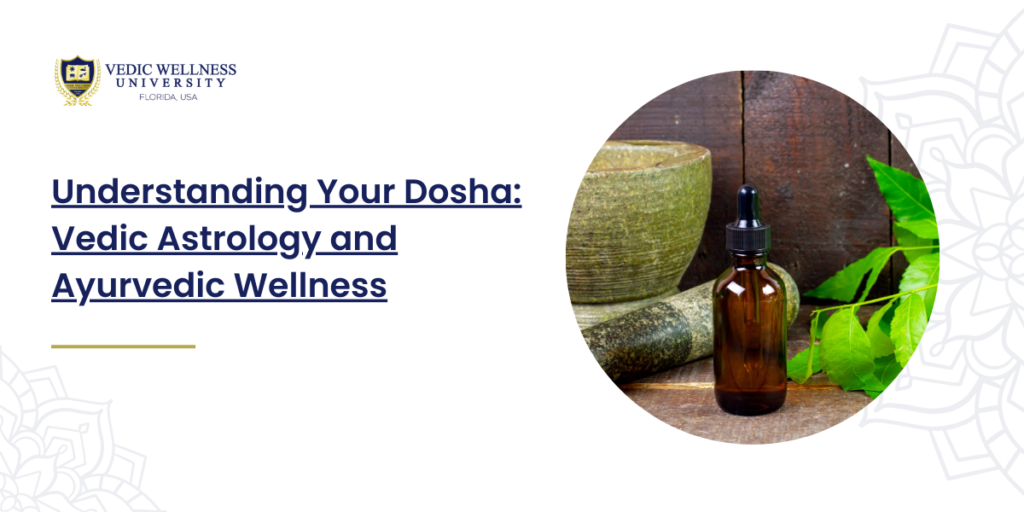
Introduction “वातपित्तश्लेष्मा शरीरधारणं चतुर्विधं दोषाणां च त्रयाणां।”(Vata Pitta Shleshma Shariradharanam Chaturvidham Doshanaam Cha Trayaanaam)“Vata, Pitta, and Kapha are the three humors that sustain the body.” In the realm of Ayurveda, the concept of Dosha is fundamental to understanding individual health and wellness. Derived from ancient Vedic texts, Doshas are biological energies found throughout the human body and mind. They govern all physical and mental processes and provide every living being with an individual blueprint for health and fulfillment. What Are Doshas? Doshas are the three fundamental bio-elements that make up our physical constitution. These are: Each Dosha is a combination of two of the five elements and is responsible for different physiological functions within the body. Understanding your primary Dosha and how it influences your physical and mental health is key to achieving balance and well-being. Types of Doshas and Their Impact 1. Vata Dosha Characteristics: Vata Dosha is composed of air and ether elements. It governs movement and is responsible for all bodily functions related to motion, including breathing, circulation, and nerve impulses. Impact on Daily Life: When Vata is balanced, it promotes creativity, flexibility, and clear thinking. Individuals with a dominant Vata Dosha are often lively, energetic, and quick-thinking. However, an imbalance can lead to anxiety, insomnia, dry skin, and digestive issues. Physical Attributes: People with a Vata constitution tend to have a light, slender body frame, and dry skin. They may experience irregular digestion and feel cold easily. Emotional Attributes: Vata types are often enthusiastic and imaginative but can become easily overwhelmed and anxious when stressed. 2. Pitta Dosha Characteristics: Pitta Dosha is made up of fire and water elements. It governs metabolism and is responsible for digestion, absorption, and body temperature. Impact on Daily Life: Balanced Pitta supports intelligence, leadership, and strong digestion. Pitta-dominant individuals are typically confident, articulate, and ambitious. However, when out of balance, Pitta can cause irritability, inflammation, and digestive disorders like acid reflux. Physical Attributes: People with a Pitta constitution usually have a medium build, warm body temperature, and oily skin. They have a strong appetite and efficient digestion. Emotional Attributes: Pitta types are often passionate and driven but can become prone to anger and impatience under stress. 3. Kapha Dosha Characteristics: Kapha Dosha combines water and earth elements. It governs structure and lubrication and is responsible for maintaining body tissues and storing energy. Impact on Daily Life: Balanced Kapha promotes stability, patience, and strength. Individuals with a dominant Kapha Dosha are generally calm, compassionate, and loyal. However, imbalance can lead to lethargy, weight gain, and respiratory issues. Physical Attributes: People with a Kapha constitution typically have a sturdy, heavier body frame, smooth skin, and strong endurance. They may experience slow digestion and a tendency to gain weight. Emotional Attributes: Kapha types are nurturing and supportive but can become overly attached and resistant to change when stressed. Ways to Counter Dosha Imbalances | Vedic Astrology 1. Balancing Vata Dosha Diet: Lifestyle: Herbal Remedies: “अपवर्गार्थं प्रवरः।”(Apavargartham Pravarah)“To overcome obstacles, the best means is self-restraint.” 2. Balancing Pitta Dosha Diet: Lifestyle: Herbal Remedies: “शमर्थे चातुर्यं।”(Shamarthe Chaturyam)“Wisdom lies in calmness.” 3. Balancing Kapha Dosha Diet: Lifestyle: Herbal Remedies: “उत्तिष्ठत जाग्रत।”(Uttishthata Jagrata)“Arise, awake, and stop not till the goal is reached.” Conclusion Understanding your Dosha through the lens of Vedic astrology and Ayurvedic wellness can provide profound insights into maintaining physical and mental health. By recognizing the unique constitution of Vata, Pitta, and Kapha within ourselves, we can adopt personalized dietary, lifestyle, and herbal remedies to achieve balance and well-being. “सर्वे भवन्तु सुखिनः, सर्वे सन्तु निरामयाः।”(Sarve Bhavantu Sukhinah, Sarve Santu Niramayah)“May all beings be happy, may all beings be free from disease.” Embracing the wisdom of Ayurveda and Vedic astrology empowers us to lead healthier, more harmonious lives, fostering a deeper connection with our natural rhythms and the world around us. At Vedic Wellness University, we are committed to integrating these ancient practices with modern knowledge, guiding individuals towards a balanced and fulfilling life.
Stress Management with Naturopathy Yoga: Vedic Methods for Mental Well-being

Introduction “स्वस्थस्य स्वास्थ्य रक्षणं, आतुरस्य विकार प्रशमनं च।”(Swasthasya Swasthya Rakshanam, Aturasya Vikar Prashamanam Cha)“To maintain the health of the healthy and to cure the diseases of the sick.” This ancient shloka from the Charaka Samhita perfectly encapsulates the essence of Ayurveda and Naturopathy Yoga. The holistic approach of these practices focuses on maintaining health and preventing diseases by harmonizing the body, mind, and spirit. The Life of Ancient Indians and Evolution of Ayurveda and Naturopathy Ancient Indians lived in harmony with nature, following lifestyles that were closely aligned with the natural world. Their daily routines, diets, and medicinal practices were deeply rooted in the principles of Ayurveda, an ancient system of medicine that emphasized balance and holistic well-being. Ayurveda, meaning “the science of life,” provided comprehensive guidelines on diet, lifestyle, and treatments to maintain health and prevent diseases. The origins of Ayurveda can be traced back to the Vedas, particularly the Atharva Veda, which contains hymns and rituals associated with healing. Over time, this knowledge was compiled and expanded upon by ancient sages, resulting in classical texts such as the Charaka Samhita and Sushruta Samhita. These texts laid the foundation for Ayurvedic practices and introduced the concept of Doshas (Vata, Pitta, and Kapha) that govern the physiological and psychological functions of the body. Parallel to Ayurveda, naturopathy emerged as a complementary approach to healing, emphasizing the body’s inherent ability to heal itself through natural means. Naturopathy incorporates elements of Ayurveda, yoga, dietetics, and lifestyle counseling to promote health and well-being. Understanding Naturopathy Naturopathy is a holistic approach to health and wellness that focuses on natural remedies and the body’s intrinsic ability to heal itself. It is grounded in several core principles: The origins of naturopathy can be traced back to ancient healing traditions that utilized natural elements such as water, herbs, and sunlight. In modern times, naturopathy has evolved to incorporate scientific advancements while staying true to its core principles. Naturopaths use a variety of treatments, including dietary changes, herbal medicine, hydrotherapy, and physical therapies, to support the body’s healing processes. Yoga and Its Integration with Naturopathy Yoga, with its origins in ancient India, is a practice that encompasses physical postures (asanas), breath control (pranayama), meditation (dhyana), and ethical principles (yamas and niyamas). The primary goal of yoga is to achieve a state of physical, mental, and spiritual harmony. The practice of yoga is mentioned in various ancient texts, including the Vedas, Upanishads, and the Yoga Sutras of Patanjali, which systematically outline the philosophy and practice of yoga. “योगः कर्मसु कौशलम्”(Yogah Karmasu Kaushalam)“Yoga is skill in action.” This shloka from the Bhagavad Gita emphasizes the importance of practicing yoga in daily life to achieve skill and balance in all actions. The integration of yoga with naturopathy is a natural synergy, as both practices share common principles of holistic health and natural healing. Here’s how yoga complements naturopathy: Benefits of Naturopathy Yoga for Stress Management Integrating naturopathy yoga into daily routines offers numerous benefits for stress management. Here are ten key benefits: Conclusion The integration of naturopathy yoga offers a powerful and holistic approach to stress management, blending ancient wisdom with modern practices. By harmonizing the body, mind, and spirit, these practices provide a comprehensive pathway to mental well-being and overall health. “सर्वे भवन्तु सुखिनः, सर्वे सन्तु निरामयाः।”(Sarve Bhavantu Sukhinah, Sarve Santu Niramayah)“May all beings be happy, may all beings be free from disease.” Embracing the principles of naturopathy yoga can lead to a balanced, healthy, and fulfilling life, empowering individuals to navigate the challenges of modern life with resilience and grace. At Vedic Wellness University, we are dedicated to promoting these timeless practices and integrating them with contemporary education to foster a global community of well-being and harmony.
The Healing Power of Vedic Chants: Exploring the Arts in Music for Wellness
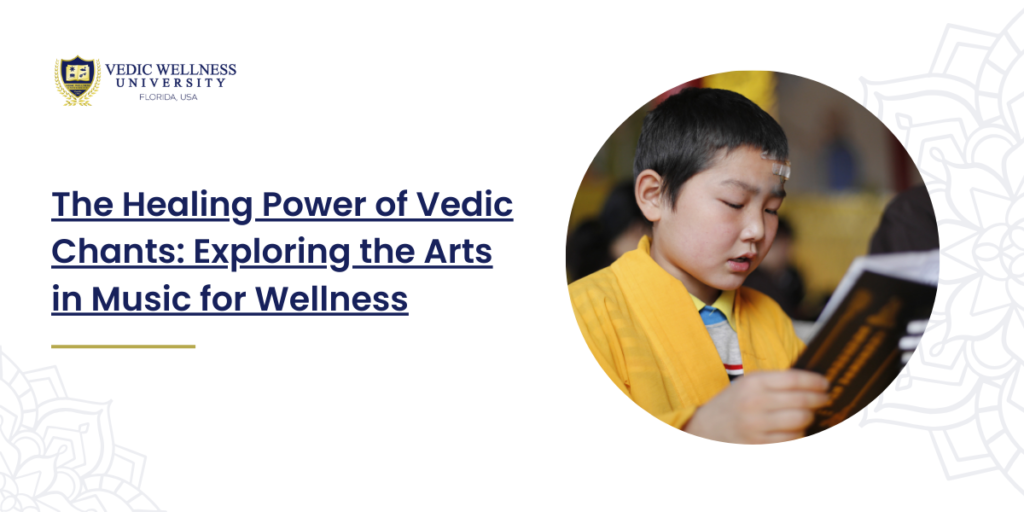
Introduction “ॐ सर्वेशां स्वस्तिर्भवतु।सर्वेशां शान्तिर्भवतु।सर्वेशां पूर्णं भवतु।सर्वेशां मङ्गलं भवतु।”(Om Sarveshaam Svastir Bhavatu,Sarveshaam Shaantir Bhavatu,Sarveshaam Poornam Bhavatu,Sarveshaam Mangalam Bhavatu)“May there be well-being in all, May there be peace in all, May there be completeness in all, May there be prosperity in all.” This ancient Vedic chants is known for its soothing and harmonizing effects on the mind and body. The repetition of “Om,” combined with the invocation of universal well-being, creates a profound sense of peace and tranquility. The rhythmic chanting aligns with our natural breathing patterns, reducing stress and anxiety while promoting mental clarity and emotional stability. Ancient Manuscripts and Texts India’s rich heritage is replete with manuscripts and texts that detail the power of Vedic chants. These scriptures have been meticulously preserved over millennia, providing invaluable insights into the use of sound and music for healing. Below are five major Indian Vedic or ancient texts that contain such scriptures. 1. Rigveda The Rigveda is one of the oldest known texts in the world, dating back to around 1500 BCE. It consists of hymns dedicated to various deities, and these hymns are chanted during rituals and ceremonies. The Rigveda emphasizes the importance of sound in connecting with the divine and harnessing its power for personal and communal well-being. 2. Sama Veda The Sama Veda is often referred to as the “Veda of melodies and chants.” It is essentially a collection of hymns from the Rigveda set to musical notation. The Sama Veda’s primary focus is on the musical aspects of chanting, making it a crucial text for understanding the integration of music and spirituality in Vedic practices. 3. Yajurveda The Yajurveda is a compilation of ritual offerings that were said during various religious ceremonies. It includes the chanting of mantras that are essential for performing Vedic rituals. The Yajurveda’s emphasis on the correct pronunciation and intonation of chants highlights the significance of sound in achieving desired outcomes in rituals. 4. Atharva Veda The Atharva Veda is known for its focus on everyday life and includes hymns and spells for health, longevity, and protection against diseases. It provides a comprehensive view of how Vedic chants can be used for practical purposes, making it highly relevant for modern-day applications in wellness and healing. 5. Bhagavad Gita While not a Vedic text per se, the Bhagavad Gita, part of the Mahabharata, contains numerous verses (shlokas) that are recited as chants. The Gita’s teachings on duty, righteousness, and the nature of the self are often conveyed through chanting, offering profound mental and spiritual benefits. Daily Life Chants for Wellness Integrating Vedic chants into daily life can significantly enhance mental and physical well-being. Here are ten major scriptures or chants to use, depending on your emotional and physical state, along with guidance on their application. 1. Gayatri Mantra “ॐ भूर् भुवः स्वः।तत्सवितुर्वरेण्यं।भर्गो देवस्य धीमहि।धियो यो नः प्रचोदयात्॥”(Om Bhur Bhuvah Swah,Tat Savitur Varenyam,Bhargo Devasya Dheemahi,Dhiyo Yo Nah Prachodayat) Situation: To start the day with positivity and clarity.Frequency: Every morning, 108 times.Impact: Enhances concentration, reduces stress, and promotes overall well-being. 2. Maha Mrityunjaya Mantra “ॐ त्र्यम्बकं यजामहे सुगन्धिं पुष्टिवर्धनम्।उर्वारुकमिव बन्धनान्मृत्योर्मुक्षीय माऽमृतात्॥”(Om Tryambakam Yajamahe Sugandhim Pushtivardhanam,Urvarukamiva Bandhanan Mrityor Mukshiya Maamritat) Situation: For health and protection against illness.Frequency: During times of illness or daily, 108 times.Impact: Provides healing, reduces fear of death, and promotes longevity. 3. Shanti Mantra “ॐ सह नाववतु।सह नौ भुनक्तु।सह वीर्यं करवावहै।तेजस्विनावधीतमस्तु मा विद्विषावहै॥”(Om Sahana Vavatu,Sahanau Bhunaktu,Sahaveeryam Karavavahai,Tejasvinavadhitamastu Ma Vidvishavahai) Situation: Before starting any educational or spiritual activity.Frequency: Once before the activity.Impact: Promotes harmony, cooperation, and effective learning. 4. Durga Mantra “ॐ ऐं ह्रीं क्लीं चामुण्डायै विच्चे॥”(Om Aim Hreem Kleem Chamundayai Vichche) Situation: For strength and courage.Frequency: During challenging times or daily, 108 times.Impact: Invokes the goddess Durga for protection, courage, and strength. 5. Saraswati Mantra “ॐ ऐं सरस्वत्यै नमः॥”(Om Aim Saraswatyai Namah) Situation: Before starting studies or creative activities.Frequency: Daily, especially before studying, 108 times.Impact: Enhances knowledge, creativity, and wisdom. 6. Hanuman Chalisa “श्री गुरु चरन सरोज रज, निज मनु मुकुरु सुधारि।बरनऊँ रघुबर बिमल जसु, जो दायकु फल चारि॥”(Shri Guru Charan Saroj Raj, Nij Manu Mukuru Sudhari,Barnaun Raghubar Bimal Jasu, Jo Dayaku Phal Chari) Situation: For removing obstacles and gaining strength.Frequency: Weekly or during difficult times.Impact: Provides strength, removes obstacles, and brings peace. 7. Vishnu Sahasranama “शान्ताकारं भुजगशयनं पद्मनाभं सुरेशं।विश्वाधारं गगनसदृशं मेघवर्णं शुभाङ्गम्॥”(Shantakaram Bhujagashayanam Padmanabham Suresham,Vishvadharam Gaganasadrisham Meghavarnam Shubhangam) Situation: For peace and prosperity.Frequency: Daily or weekly.Impact: Brings peace, prosperity, and spiritual growth. 8. Lakshmi Mantra “ॐ श्रीं महालक्ष्म्यै नमः॥”(Om Shreem Mahalakshmyai Namah) Situation: For wealth and abundance.Frequency: Daily, 108 times.Impact: Attracts wealth, prosperity, and good fortune. 9. Ganesh Mantra “ॐ गं गणपतये नमः॥”(Om Gam Ganapataye Namah) Situation: Before starting new ventures.Frequency: Daily, 108 times.Impact: Removes obstacles and ensures success in new endeavors. 10. Guru Mantra “गुरु ब्रह्मा गुरु विष्णु गुरु देवो महेश्वरः।गुरुः साक्षात् परं ब्रह्म तस्मै श्री गुरवे नमः॥”(Guru Brahma Guru Vishnu Guru Devo Maheshwarah,Guruh Saakshaat Param Brahma Tasmai Shri Gurave Namah) Situation: For guidance and wisdom.Frequency: Daily, especially before learning or seeking advice.Impact: Provides clarity, wisdom, and spiritual guidance. Conclusion Our ancient Indian Vedas and texts are a treasure trove of wisdom and practical tools for living a better, healthier, and more fulfilling life. The power of Vedic chants, when integrated into our daily routines, can bring about profound changes in our mental, emotional, and physical well-being. By exploring the arts in music and understanding the significance of these ancient practices, we can reconnect with our roots and harness the healing power of sound for a balanced and harmonious life. “वसुधैव कुटुम्बकम्”(Vasudhaiva Kutumbakam)“The world is one family.” Embracing this holistic approach through Vedic Wellness University can guide us towards a path of well-being, unity, and universal harmony.
Best Method of Learning Vedic Maths
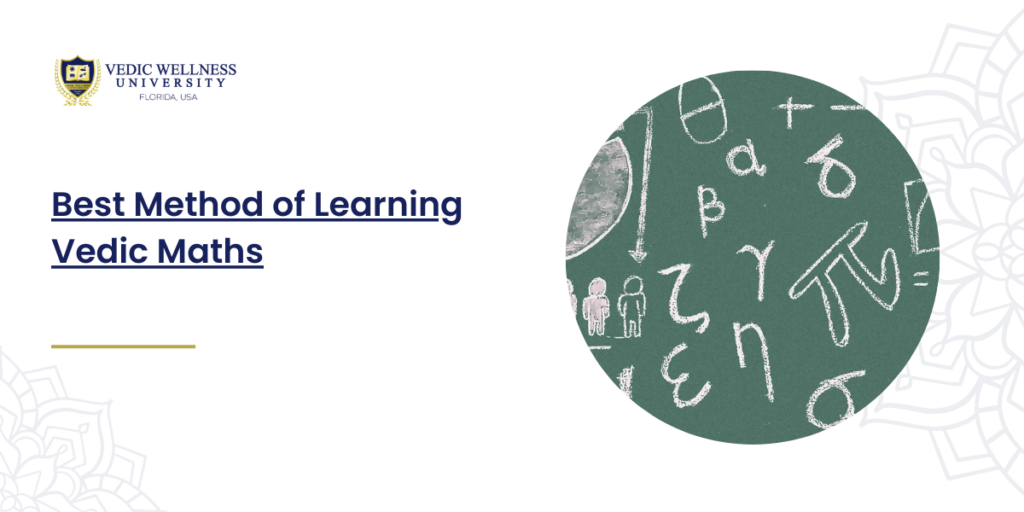
Introduction to Vedic Mathematics “सत्यं ज्ञानमनन्तं ब्रह्म”(satyam jñānam anantam brahma)“Truth, knowledge, and infinity are Brahman.” Vedic Maths is an ancient Indian system of mathematics that originated from the Vedas, specifically the Atharva Veda. It was rediscovered in the early 20th century by Sri Bharati Krishna Tirthaji, who compiled it into a system of 16 sutras (aphorisms) and 13 sub-sutras. These sutras encompass various mathematical operations and problem-solving techniques that make calculations simpler and faster. Vedic Mathematics was traditionally taught through oral transmission and manuscripts, emphasizing mental calculations and intuitive understanding. Importance of Vedic Mathematics in Modern Day In today’s fast-paced world, the ability to perform quick and accurate calculations is invaluable. Vedic Mathematics offers a significant advantage to students preparing for competitive exams like CAT, GMAT, and GRE, where speed and accuracy in solving mathematical problems are crucial. Beyond academic exams, Vedic Mathematics is also beneficial in everyday life, enhancing one’s ability to perform mental arithmetic and problem-solving with ease. Common Uses of Vedic Mathematics in Modern Day 1. Quick Calculations Vedic Mathematics simplifies complex calculations, enabling quick mental arithmetic. This is particularly useful in competitive exams where time is limited, allowing students to solve problems faster and more accurately. 2. Cross-Checking Answers Vedic Mathematics provides methods for verifying answers quickly. Techniques like the digital root method help in cross-checking answers, ensuring accuracy in calculations, which is particularly useful in examinations and professional settings. 3. Enhancing Cognitive Skills Learning Vedic Maths enhances cognitive abilities such as memory, concentration, and analytical thinking. These skills are beneficial not only in academics but also in professional and personal life. 4. Simplifying Algebraic Calculations Vedic Mathematics offers straightforward methods for solving algebraic equations. Techniques such as the Vertically and Crosswise method simplify multiplication and division of algebraic expressions, making it easier for students to understand and solve algebraic problems. 5. Boosting Confidence in Mathematics The ease and speed of calculations provided by Vedic Maths boost students’ confidence in their mathematical abilities. This confidence translates into better performance in exams and a more positive attitude towards learning mathematics. 6. Applications in Various Fields Vedic Mathematics finds applications in various fields such as engineering, computer science, and finance. The methods and techniques can be used to simplify complex calculations, optimize algorithms, and enhance computational efficiency. Scientific Applications of Vedic Mathematics As we look towards the future, the principles of Vedic Mathematics hold potential for various scientific applications. Here are five models that could be developed using Vedic mathematical principles: 1. Optimized Algorithm Design Vedic Mathematics can inspire the development of optimized algorithms for computational tasks. Techniques such as the Vertically and Crosswise method can be adapted to create faster and more efficient algorithms for data processing and analysis. 2. Cryptographic Systems The simplicity and speed of Vedic mathematical calculations can be utilized to develop robust cryptographic systems. These systems can enhance data security by using complex mathematical operations that are quick to compute but difficult to break. 3. Quantum Computing Models Quantum computing, which relies on principles of superposition and entanglement, could benefit from the intuitive and efficient methods of Vedic Mathematics. Developing quantum algorithms based on Vedic principles could lead to breakthroughs in computational speed and efficiency. 4. AI and Machine Learning Artificial Intelligence (AI) and Machine Learning (ML) models require extensive calculations and optimizations. Vedic Mathematics can contribute to developing more efficient algorithms for training and deploying AI/ML models, improving their performance and reducing computational costs. 5. Financial Modelling In finance, Vedic Mathematics can aid in the development of models for risk assessment, investment strategies, and market predictions. The quick and accurate calculation methods can enhance the precision and reliability of financial models. Conclusion Vedic Mathematics is a timeless system that bridges ancient wisdom with modern needs. Its principles offer quick and efficient methods for mathematical calculations, making it invaluable for students, professionals, and researchers alike. As we continue to explore its applications, Vedic Mathematics holds the potential to revolutionize various scientific and technological fields. The future of Vedic Mathematics is promising, with endless possibilities for innovation and discovery. “आ नो भद्राः क्रतवो यन्तु विश्वतः”(ā no bhadrāḥ kratavo yantu viśvataḥ)“Let noble thoughts come to us from every side.” Embracing the holistic approach of Vedic Mathematics can lead to a better understanding of the universe, fostering growth and enlightenment in every aspect of life.
Learning Vedic Astrology Step By Step For Beginners
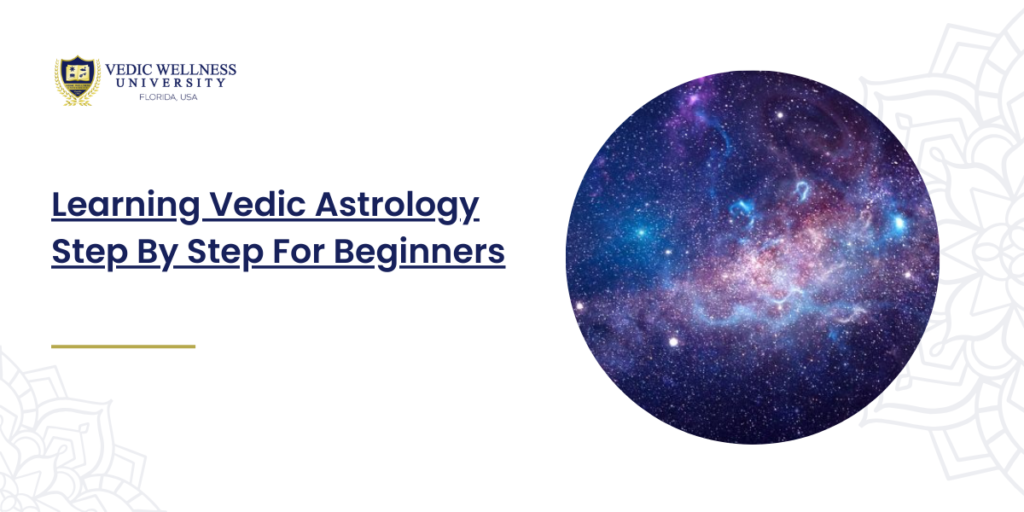
Introduction “सर्वं ज्ञानं मयि विद्यते”(sarvaṁ jñānaṁ mayi vidyate)“All knowledge is within me.” Vedic astrology, known as Jyotish Shastra, is an ancient science rooted in the Vedas, the oldest sacred texts of Hinduism. The origins of Vedic astrology can be traced back to the Rigveda, around 1500 BCE, where celestial bodies were observed and their influence on human life was recorded. Over millennia, Vedic astrology has evolved, incorporating advancements in astronomy and blending seamlessly with modern scientific principles. This holistic approach has made learning Vedic astrology a fascinating journey for enthusiasts worldwide. Origins and Evolution of Vedic Astrology The earliest known mention of Vedic astrology is found in the Rigveda, which documents the alignment of planets and stars with human destiny. The science was further refined by ancient scholars who wrote extensive texts on the subject, such as “Brihat Samhita” by Varahamihira and “Brihat Parashara Hora Shastra” by Parashara. These texts laid the foundation for the systematic study of astrology, including the development of various branches such as natal astrology, electional astrology, and mundane astrology. As time progressed, Vedic astrology integrated mathematical precision with spiritual insights, making it a comprehensive tool for understanding life’s complexities. Today, Vedic astrology is recognized for its accuracy and depth, offering insights that align with contemporary scientific discoveries. Notable Indian Scholars in Vedic Astrology 1. Varahamihira Varahamihira was a renowned scholar and author of “Brihat Samhita,” a classical text that covers various aspects of astrology, astronomy, and weather prediction. 2. Parashara Parashara is credited with writing “Brihat Parashara Hora Shastra,” a fundamental text that forms the backbone of Vedic astrology. His work is still widely studied and respected. 3. Aryabhata Aryabhata was a mathematician and astronomer whose work, “Aryabhatiya,” includes significant contributions to astrology and astronomy, especially in calculating planetary positions. 4. Bhrigu Bhrigu, one of the seven great sages, authored the “Bhrigu Samhita,” a comprehensive astrological classic that provides detailed predictions and analyses based on individual horoscopes. 5. Kalyana Varma Kalyana Varma wrote “Saravali,” a key text in Vedic astrology that offers detailed explanations of astrological principles and their applications. Modern Day Applications of Vedic Astrology 1. Personal Life Guidance Learning Vedic astrology can provide deep insights into personal lives, helping individuals understand their strengths, weaknesses, and life purpose. By analyzing birth charts, astrologers can offer personalized advice on various life aspects. 2. Career Counseling Astrology can guide individuals in choosing careers that align with their inherent skills and planetary influences. This alignment can lead to greater job satisfaction and professional success. 3. Relationship Compatibility Vedic astrology is often used to analyze compatibility between partners, aiding in the selection of harmonious and fulfilling relationships. This practice is commonly used in marriage arrangements in India. 4. Health Predictions Astrological charts can indicate potential health issues and guide individuals towards preventive measures and holistic healing practices. This approach helps in maintaining overall well-being. 5. Financial Planning Astrological insights can assist in making informed financial decisions, identifying auspicious times for investments and business ventures. This guidance can lead to better financial stability and growth. 6. Spiritual Growth Astrology aids in understanding one’s spiritual path and karmic influences, promoting spiritual growth and self-awareness. It helps individuals align their actions with their spiritual goals. 7. Electional Astrology Choosing the most auspicious times (Muhurta) for important events such as marriages, business launches, and other significant undertakings can ensure success and harmony. 8. Education and Learning Guidance on the best times to start educational pursuits and the most suitable fields of study based on individual charts can enhance learning experiences and outcomes. 9. Remedial Measures Vedic astrology suggests remedies like gemstones, mantras, and rituals to mitigate negative planetary influences and enhance positive ones. These measures can improve life circumstances. 10. Psychological Insights Astrology offers insights into one’s psychological makeup, aiding in personal development and emotional well-being. It helps individuals understand and manage their emotions better. Career Opportunities in Vedic Astrology 1. Astrologer Requires at least a diploma in Vedic astrology. Astrologers provide consultations, and their remuneration can range from ₹50,000 to ₹2,00,000 per month depending on their clientele and reputation. 2. Astrological Writer/Author A degree in Vedic studies or astrology is beneficial. Authors write books, articles, and blogs. Earnings vary widely, from ₹30,000 to ₹1,50,000 per month. 3. Researcher Requires a PhD in Vedic astrology or related fields. Researchers work in academic institutions or independently, with potential earnings ranging from ₹60,000 to ₹1,50,000 per month. 4. Astrological Software Developer A background in IT along with knowledge of astrology. Developers create astrological software and apps, with salaries starting from ₹70,000 per month. 5. Vedic Astrology Teacher Requires at least a graduate degree in Vedic astrology. Teachers educate students at universities or online platforms, earning between ₹40,000 to ₹1,00,000 per month. Step by Step Guide to Becoming a Scholar in Vedic Astrology 1. Understanding the Basics Start by learning the fundamentals of Vedic astrology, including the significance of planets, houses, and zodiac signs. Read introductory books and take online courses to build a solid foundation. 2. Formal Education Enroll in a diploma or degree program in Vedic astrology at a recognized institution like Vedic Wellness University. These programs provide structured learning and comprehensive knowledge, covering various aspects of astrology. 3. Practice and Application Practice by reading charts and offering free consultations to friends and family. This hands-on experience is crucial for honing your skills and gaining practical insights into astrological interpretations. 4. Advanced Studies Pursue advanced courses or a master’s degree to deepen your understanding of complex astrological concepts and techniques. Specialized courses in areas like medical astrology or financial astrology can enhance your expertise. 5. Research and Specialization Specialize in a particular area such as medical astrology, financial astrology, or relationship astrology. Conduct research and contribute to the field by publishing papers and books, establishing yourself as an expert. Conclusion The scope of Vedic astrology is vast and continually expanding. With its profound insights and practical applications, it offers valuable guidance in various aspects of life. As more people seek deeper understanding
Ethics and Morality in Vedic Philosophy: Lessons for Today’s Society
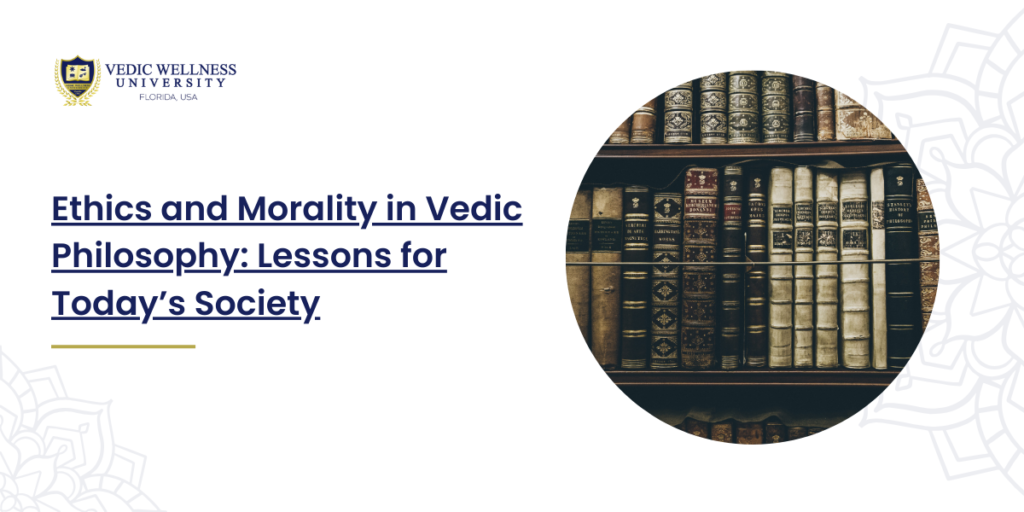
Introduction “सत्यं वद, धर्मं चर”(Satyam Vada, Dharmam Chara)“Speak the truth, practice righteousness.” This shloka from the Taittiriya Upanishad captures the essence of Vedic Philosophy concerning ethics and morality. It underscores the importance of truth and righteousness as fundamental virtues. However, ethics and morality are not absolute; they are subjective and can vary from person to person and culture to culture. The Vedas and ancient Indian texts acknowledge this complexity, recognizing that ethical dilemmas often involve grey areas rather than clear-cut black-and-white decisions. Subjectivity of Ethics and Morality in Vedic Philosophy The Vedas, Upanishads, and other ancient texts present a nuanced view of ethics and morality, reflecting the diversity of human experience. They offer guidance on living a virtuous life while acknowledging that moral decisions can be context-dependent and subjective. This flexibility is evident in the texts, which often present contrasting perspectives to illustrate the complexity of moral choices. Texts Touching on Ethics and Morality in the Vedas 1. Dharma and Duty Text: Bhagavad Gita “कर्मण्येवाधिकारस्ते मा फलेषु कदाचन।मा कर्मफलहेतुर्भूर्मा ते सङ्गोऽस्त्वकर्मणि॥”(Karmanye Vadhikaraste Ma Phaleshu Kadachana,Ma Karma Phala Hetur Bhur Ma Te Sango Stv Akarmani)“You have a right to perform your prescribed duties, but you are not entitled to the fruits of your actions. Never consider yourself the cause of the results of your activities, nor be attached to inaction.” “त्यक्त्वा कर्मफलं संगं नित्यतृप्तो निराश्रयः।कर्मण्यभिप्रवृत्तोऽपि नैव किञ्चित्करोति सः॥”(Tyaktva Karma Phalam Sangam Nitya Trupto Nirasrayah,Karmany Abhipravritto Api Naiva Kinchit Karoti Sah)“By renouncing the fruits of actions, one attains eternal peace. The wise, absorbed in action, achieve the highest good, yet they are free from attachment.” The Bhagavad Gita discusses dharma (duty) and the ethical implications of performing one’s duty without attachment to the results. While one shloka emphasizes duty for its own sake, another highlights the peace achieved by renouncing the fruits of action, illustrating the complexity of ethical behavior. 2. Truth and Deception Text: Mahabharata “सत्यं ब्रूयात् प्रियं ब्रूयात् न ब्रूयात् सत्यमप्रियम्।प्रियं च नानृतं ब्रूयात् एष धर्मः सनातनः॥”(Satyam Bruyat Priyam Bruyat Na Bruyat Satyam Apriyam,Priyam Cha Nanritam Bruyat Esha Dharma Sanatanah)“Speak the truth, speak what is pleasant, do not speak the unpleasant truth, do not speak the pleasant lie. This is the eternal law.” “सर्वं धर्मं प्रवक्तव्यं यथावृत्तं यथाश्रुतम्।नानृतं तत्र वक्ष्यामि नैव ब्रूयां कदाचन॥”(Sarvam Dharmam Pravaktavyam Yathavruttam Yathashrutam,Nanritam Tatra Vakshyami Naiva Bruyam Kadachana)“All dharma should be narrated as it is, as heard, without speaking falsehood, nor should falsehood ever be spoken.” These shlokas from the Mahabharata present a nuanced view on truth and deception. While one emphasizes the importance of speaking truthfully and pleasantly, the other insists on narrating dharma as it is, without any falsehood, highlighting the delicate balance in ethical communication. 3. Non-Violence and Just War Text: Rigveda “अहिंसा परमो धर्मः धर्म हिंसा तथैव च।”(Ahimsa Paramo Dharmah Dharma Himsa Tathaiva Cha)“Non-violence is the highest duty, and so is violence in the service of duty.” “उद्धरेदात्मनात्मानं नात्मानमवसादयेत्।आत्मैव ह्यात्मनो बन्धुरात्मैव रिपुरात्मनः॥”(Uddhared Atmanatmanam Natmanam Avasadayet,Atmaiva Hyatmano Bandhur Atmaiva Ripuratmanah)“One must elevate oneself by one’s own mind, not degrade oneself. The mind is the friend of the conditioned soul, and his enemy as well.” The concept of non-violence is central to Vedic Philosophy, yet the Rigveda and Mahabharata acknowledge that violence may be necessary in the service of dharma. This dual perspective highlights the complexity of ethical decision-making in matters of war and peace. 4. Charity and Self-Sufficiency Text: Manusmriti “तैर्दत्तं हृष्टमनसः स्वधर्मेणार्जितं धनम्।तेन स्वर्गं गमिष्यन्ति ततः शेषं हरीष्यति॥”(Tair Dattam Hrishta Manasah Swadharmenarjitam Dhanam,Tena Svargam Gamishyanti Tatah Shesham Harishyati)“Charity given with a cheerful heart and by right means leads to heaven; the rest is taken away by fate.” “स्वधर्मे निधनं श्रेयः परधर्मो भयावहः।”(Svadharme Nidhanam Shreyah Paradharmo Bhayavahah)“It is better to die in one’s own duty; perilous is it to follow the duty of another.” The Manusmriti and Bhagavad Gita discuss the virtues of charity and self-sufficiency. While one shloka extols the merits of charitable acts, another emphasizes the importance of adhering to one’s own duty, illustrating the nuanced approach to ethics in Vedic Philosophy. 5. Wealth and Contentment Text: Upanishads “तेन त्यक्तेन भुञ्जीथा मा गृधः कस्यस्विद्धनम्।”(Tena Tyaktena Bhunjitha Ma Gridhah Kasyasvid Dhanam)“Enjoy wealth with detachment; do not covet others’ wealth.” “न कर्मणा न प्रजया धनेन त्यागेनैके अमृतत्वमानशुः।”(Na Karmana Na Prajaya Dhanena Tyagenaike Amritatvamanashuh)“Neither by actions, nor by progeny, nor by wealth, but by renunciation alone is immortality attained.” The Isha and Kaivalya Upanishads offer differing perspectives on wealth and contentment. While one advocates enjoying wealth without attachment, the other suggests that renunciation is the path to immortality, highlighting the varied ethical views within Vedic texts. 6. Forgiveness and Justice Text: Ramayana “क्षमा धर्मस्य भूषणं क्षमा वीरस्य भूषणं।क्षमा यशसि भूषणं क्षमा शौर्यस्य भूषणं॥”(Kshama Dharmasya Bhushanam Kshama Virasya Bhushanam,Kshama Yashasi Bhushanam Kshama Shauryasya Bhushanam)“Forgiveness is the ornament of dharma, valor, fame, and heroism.” “शठे शाठ्यं समाचरेत्।”(Shathe Shathyam Samacharet)“One must respond to a deceitful person with deceit.” The Ramayana and Manusmriti present contrasting views on forgiveness and justice. While one extols forgiveness as a virtue, the other suggests that deceit should be met with deceit, reflecting the situational ethics in Vedic Philosophy. 7. Purity and Pragmatism Text: Chandogya Upanishad “सत्यं तद्विति सत्यमेवेत्याचक्षते।”(Satyam Tad Viti Satyamevetyachakshate)“That which is true is said to be truth.” “न तत्सत्यम् यद् भूतहितम्।”(Na Tat Satyam Yad Bhuta Hitam)“That is not true which is not beneficial to all beings.” The Chandogya Upanishad and Mahabharata explore the concepts of purity and pragmatism. While one shloka emphasizes absolute truth, the other highlights the importance of truth being beneficial, showcasing the ethical relativity in Vedic texts. 8. Respect and Disobedience Text: Upanishads “मातृ देवो भव। पितृ देवो भव। आचार्य देवो भव।”(Matru Devo Bhava, Pitru Devo Bhava, Acharya Devo Bhava)“Respect your mother, respect your father, respect your teacher.” “यदा यदा हि धर्मस्य ग्लानिर्भवति भारत।अभ्युत्थानमधर्मस्य तदात्मानं सृजाम्यहम्॥”(Yada Yada Hi Dharmasya Glanir Bhavati Bharata,Abhyutthanam Adharmasya Tadatmanam Srijamyaham)“Whenever there is a decline in righteousness and an increase in unrighteousness, I incarnate myself.” The Taittiriya Upanishad and Bhagavad Gita discuss respect and disobedience. While one emphasizes respect for elders and teachers, the other highlights the need for divine intervention when

